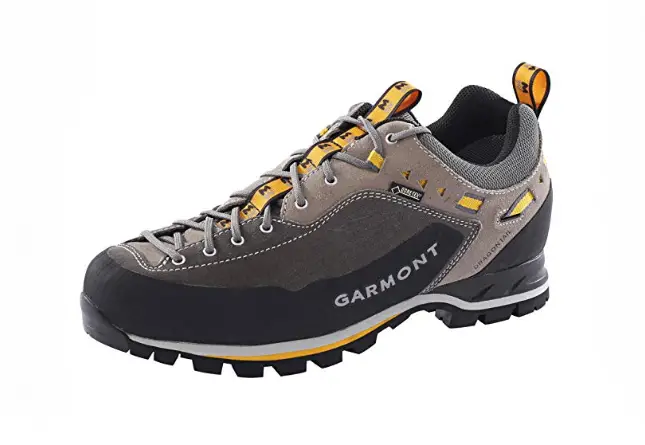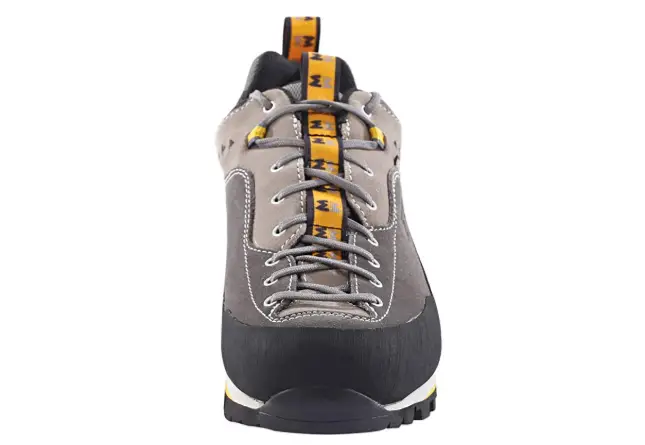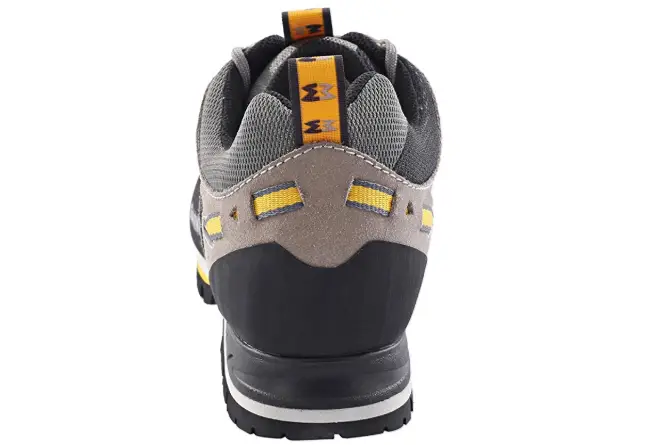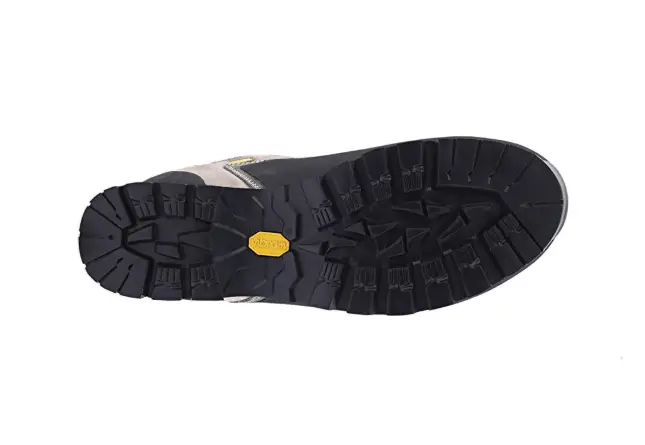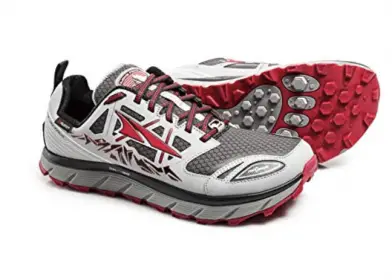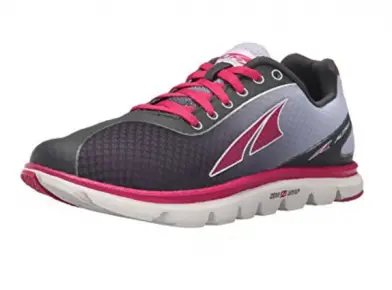Garmont Dragontail MNT GTX Approach Shoe
Garmont Dragontail MNT GTX Approach Shoe Review Facts
The route to a great climbing location can have quite a few different terrains. An active climber can usually be found scrambling over boulder fields, hiking through dense forest, slogging through wet snow, and even trying to make their way over a sand dune or two in the hopes of getting to that next great climb. No matter what terrain you expect, it pays to have an approach shoe that can truly handle it all. The Garmont Dragontail MNT GTX Approach shoe aims to do just that, and with its superior protection, tread, and durability, it does come remarkably close.
Editor's Pros & Cons
Pros
- Great for technical climbing
- Excellent stability
- Laces can easily be adjusted for a personalized fit
- Fantastic for use with a heavy pack or over long approaches
Cons
- Can be somewhat stiff
- Can run a bit small
- Not suitable for edging or smearing
Outsole
The outsole portion of this approach shoe features a Vibram Maton material that is strong, durable, and relatively lightweight. Most climbers found it to be a great asset overall in a wide range of terrains including forested, alpine and somewhat rocky environments. However, many were left somewhat disappointed by the lack of stickiness seen. It proved to be a great choice for steep inclines and rocky terrain, but actually underperformed when it came to edging and smearing, or other more technical aspects of climbing.
One nice feature, however, was the fact that both the toe box area and the heel strike area had added protection and material that was designed to absorb the striking impact, which can be rather forceful especially on rough terrain. In addition, the heel area of the outsole had a slightly concave shape, which made braking while sliding down slopes somewhat easier overall.
One nice feature, however, was the fact that both the toe box area and the heel strike area had added protection and material that was designed to absorb the striking impact, which can be rather forceful especially on rough terrain. In addition, the heel area of the outsole had a slightly concave shape, which made braking while sliding down slopes somewhat easier overall.
Midsole
The mid-sole area of this shoe is divided into three main areas. The first is the removable insole, made from FrameFlex Lite material that is designed to easily wick moisture and odor away from your feet and to give an extra layer of stability overall while going over rough terrain. The dual density microporous rubber mid-sole area adds a bit of stiffness to the mix and helps to evenly distribute the weight of each footfall, making it easier to handle heavier loads over longer distances. Finally, the PU footbed and heel insert provide an extra level of overall stability that comes in very handy during both the hike to the climb locale and some of the basic climbing.
Upper
Like quite a few approach shoes on the market today, the upper portion of this shoe is made primarily from micro-suede material that is designed to breathe well and provide great overall flexibility while on the move. It’s approximately 1.8 mm thick overall, so it is a bit thinner than others on the market, so tears and abrasions might become an issue with repeated used over rougher terrain. However, both the toe box area and the heel have rubber reinforcements for added protection in these typically problematic areas. Another nice feature is that the eyelets for the laces are made of metallic material, which helps to ensure that the laces aren’t easily frayed, and lacing is fairly simple. And finally, a small feature of the upper portion that proved to be a huge asset is the fact that there is both a heel grab and a tongue grab on these shoes. Having two points where the shoe can be easily held while putting on or taking them off did prove to be a great help, especially when the shoes were covered in muck, grime, or snow.
Breathability
Overall, we couldn’t complain too much about the ventilation in the Garmont Dragontail MNT GTX approach shoes. The micro-suede uppers provided plenty of pores and spaces for easy breathability, and the Gore-Tex lining was great at letting air through with letting moisture pass. It should be noted, however, that the breathability of the shoes decreased a significant amount when dirty, with the pore spaces being easily clogged by dirt and grime.
Comfort
Unfortunately, one of the areas that these shoes proved to be less than ideal was in the comfort category. For many people the proved to run a bit on the small size. And while there was often plenty of room in the toe box area, most found the shoes to pinch somewhat in the instep and heel areas. These shoes are definitely not recommended for those with wider feet overall. They can also have a longer break-in period than most, and for quite a while the shoes can have an uncomfortably snug and stiff feel to them.
Style
The style of these approach shoes is really nothing to write home about. They can be easily worn for outdoor activities in many different settings, and for casual social gatherings, but we wouldn’t recommend wearing them to the office. However, their classic lines and coloring schemes can easily blend into most situations. The manufacturer of these approach shoes clearly focused on having a more pragmatic approach for them instead of a fashionable one.
Durability
Perhaps the one area where these approach shoes from Garmont truly excel is in the durability arena. Simply put, these shoes are tanks when it comes to longevity and toughness. Quite a few customers marveled at their sheer toughness and durability. Both the upper portions and the outsole showed very little wear and tear even after months of rigorous use, despite the uppers relative thinness. The seams and where the different portions of the shoes join together, often problem areas for fraying and deterioration, were shown to be well made and tightly sewn. While the occasional scuff marks and abrasions did occur in the upper portion of the shoe, for the most part, these shoes could take a beating and come back for more.
Protection
These shoes provide a moderate amount of protection overall from both wear and tear and the weather. Areas that are commonly abused during climbing, such as the toe box and heel areas were further reinforced with rubberized material, and the water-resistant suede provided some protection from moisture and odor. Also, the optional Gore-Tex lining did provide an extra boost in the all-weather protection without sacrificing too much ventilation overall.
Responsiveness
As far as the shoes’ responsiveness, the Garmont Dragontail MNT GTX provided us with mixed results. During the approach and hiking over a variety of terrains, these shoes succeeded in providing stability and grip. When it came time to actually climb, including smearing and crack climbing, the shoes’ stiffness proved to be a bigger problem. The toe box area, although roomy didn’t allow for much in the way of flexibility, which is more or less essential when going for a difficult toehold. Also, the thickness of the outsole, which proved to be a great boon in protecting the bottom of the foot more or less got in the way when trying to feel out the rock during smearing or edging. Simply put, when performing climbing activities where sensitivity and responsiveness were essential, these shoes left much to be desired.
Support
If your approach is likely to prove to be a longer one, or you’re carrying a heavier load overall, these shoes from Garmont are a fantastic choice. The flexible mid-sole and insole portions provide great overall weight distribution, and the thick outsole not only provides great protection but a bit of cushioning as well. Here, the shoes overall stiffness isn’t too much of a bother, providing instead a good bit of stability and support while traversing rougher terrain.
Terrain
These shoes proved to be ideal for the climber who spends the majority of their time in more alpine or foothills settings. While not ideal for climbs with a great deal of smearing or edging, they proved to be more than adequate to help transverse areas with boulders, rocky terrain, and good amounts of snow and ice. The added support and protection overall also proved to be most beneficial during longer approach treks where a mountaineering boot would have been the classic choice.
Price
Truth be told, these aren’t the cheapest approach shoes on the market today. The prices found online ranged quite a bit, but mainly fell between the $130 and $200 USD range, with the majority of them hovering around that upper limit. However, given the overall durability and versatility of the shoe, spending a bit more money might be considered a good investment.
Traction
While the stickiness of the tread does leave quite a bit to be desired in these shoes, they do prove to be quite adequate in the traction department when it comes to scrambling up to the approach. The treads themselves feature six-inch deep grooves that help to provide great overall traction and make cleaning them a fairly simple process. In addition, the shoes’ concave heel helps to slow down a climbers descent by providing the ability to easily grip the rock with the heel area when sliding. Trust us, that small, seemingly insignificant feature can prove to be quite useful in certain situations.
Flexibility
Unfortunately, especially for avid climbers, these shoes proved to be less than flexible overall. The thick outsoles and overall construction proved to provide more stiffness and stability then flexibility. While they are more than adequate for longer approaches where weight distribution and stability are paramount, they are certainly less than ideal for climbs that call for a significant amount of edging, smearing or crack climbing.
Stability
One of the nice things about these shoes is that they are extremely stable overall. Support is provided in key areas around the shoe to help distribute weight evenly and help prevent ankle twists and turns, even with its relatively low profile. Many users compared these shoes to their mountaineering boots when it came to overall safety and stability.
Comparison to Other Brands
When compared with other brands, this shoe from Garmont proved to be the winner when it came to overall versatility, stability, and support. It easily beat out more specialized footwear from the likes of Scarpa and La Sportiva when it came to a general approach shoe and was also shown to have a greater durability overall. However, there were quite a few times when the brands that were more focused on actual climbing, such as Five Ten or Black Diamond proved to be more adept at the actual climbing portion of the escapade. It was also shown to be somewhat heavier than most approach shoes of comparable size or price. Simply put, the Garmont Dragontail MNT GTX proved to be a great general choice for getting you to the climbing locale, not necessarily a great choice to get you up the cliff face.
The Bottom Line
The Garmont Dragontail MNT GTX approach shoes are a moderately priced investment that will serve you well over a variety of terrains and weather conditions. They are somewhat heavy and stiff overall but do provide a great deal of stability, support, and weight distribution, which proves to be essential during the longer approaches, or when carrying a significant equipment load. They also provide a moderate amount of protection from abrasions and inclement weather with the micro-suede upper and optional Gore-Tex Lining.
However, depending on the actual climb, their relative lack of responsiveness and flexibility may prove to be more of a hindrance than expected. So if you’re looking for a pair of approach shoes that can handle a wide range of terrains, and are willing to carry an extra pair of shoes to wear when you get to the more technical aspects of the climb at the end of your approach, these shoes could be just what you’re looking for.
However, depending on the actual climb, their relative lack of responsiveness and flexibility may prove to be more of a hindrance than expected. So if you’re looking for a pair of approach shoes that can handle a wide range of terrains, and are willing to carry an extra pair of shoes to wear when you get to the more technical aspects of the climb at the end of your approach, these shoes could be just what you’re looking for.





